The Microsoft Surface Book 3 (15-Inch) Review: A Refreshing Dip Into Ice Lake
by Brett Howse on June 3, 2020 9:00 AM ESTGPU Performance
The original Surface Book shipped with a relatively meager GPU in the keyboard base, but Microsoft added the Performance Base as a mid-cycle refresh which redefined the Surface Book category. You can still opt for the 13.5-inch model without a GPU, or get it with the GeForce GTX 1650 Max-Q. That’s a big upgrade over the outgoing GTX 1050 in the smaller Book. Meanwhile the bigger 15-inch Book 3 upgrades from the outgoing GTX 1060 to the GTX 1660 Ti. The new Turing-based GPUs don’t offer the ray-tracing hardware found on the RTX series, but are both a big step-up from the outgoing models in all other respects.
For the first time ever, Microsoft is also offering a Quadro option as well, with the Quadro RTX 3000. This is an even more powerful GPU than the GTX 1660 Ti, so not only should you see better performance, but you get NVIDIA's RT cores as well. From a hardware perspective the Quadro RTX 3000 is functionally equivalent to the GeForce RTX 2060, with 1920 CUDA Cores, so it is a bit of a surprise that Microsoft didn't make a GeForce RTX 2060 an option. That said, on paper the Quadro RTX 3000 is perhaps a bit too powerful for a device like the Surface Book 3 – it's almost certainly running at the lower-end of its TDP range to fit in here – which is a hint that there's more going on. NVIDIA's notebook GPU stack is notably inconsistent between the GeForce and Quadro families, and the company doesn't have a true Quadro equivalent of the GTX 1660 Ti. so from a TDP standpoint, the Quadro RTX 3000 is the next closest thing available.
To see how the new Surface Book 3 fares in GPU tests, we’ve run it through our gaming workloads. We’d love to add some more productivity tests that can leverage the GPU as well, so if you have any feedback please reach out.
As with the CPU tests, most of the notebooks the Surface Book 3 will be compared against will be Ultrabooks with no GPU. Unfortunately, we’ve not had any mid-range gaming laptops recently to see where the GPU stacks up. You can of course compare these results against any other system we have tested using our Online Bench.
We’ll start with some synthetics and then move on to gaming workloads.
3DMark
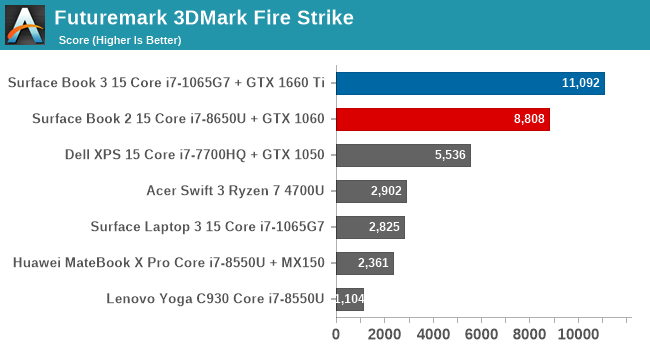
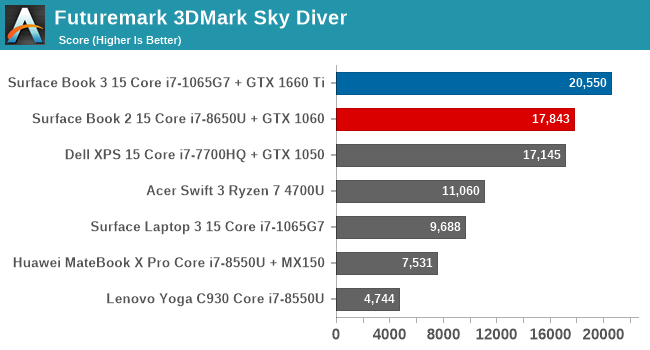
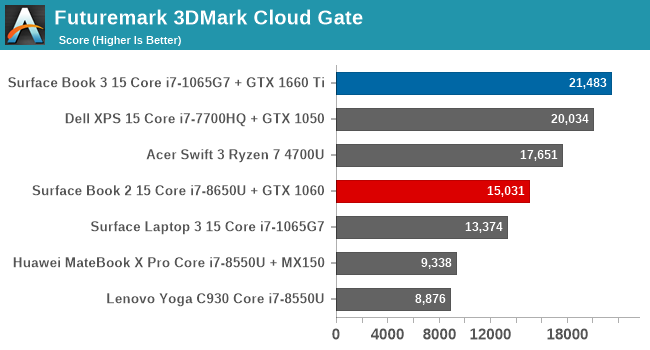
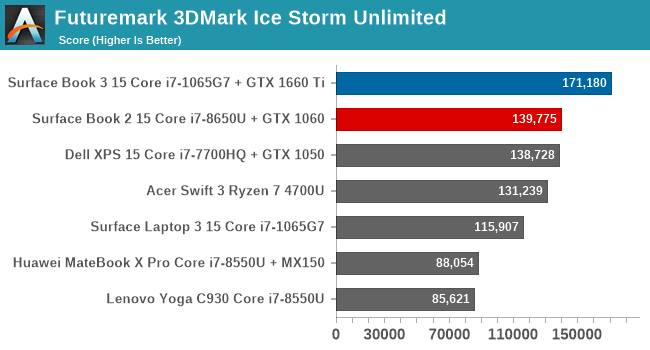

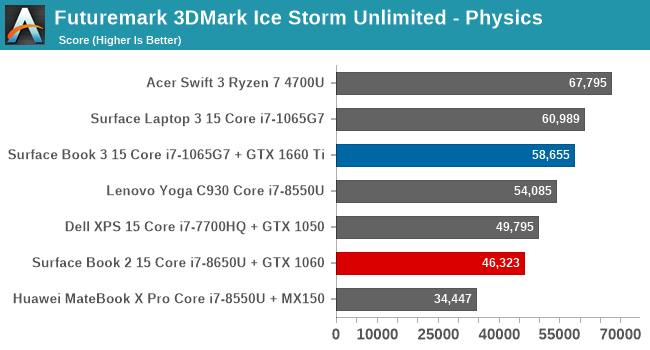
UL’s 3DMark tests a couple of different scenarios, from the very complex Fire Strike down to Ice Storm Unlimited which can be run on smartphones. As the scenes get less complex, the CPU becomes more of a bottleneck. The new CPU and GPU offer a significant increase in performance over the outgoing model.
GFXBench
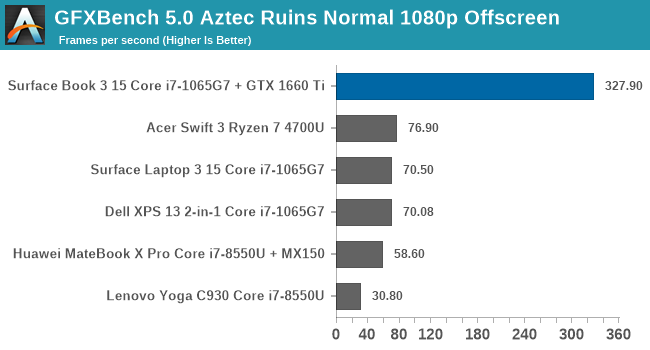
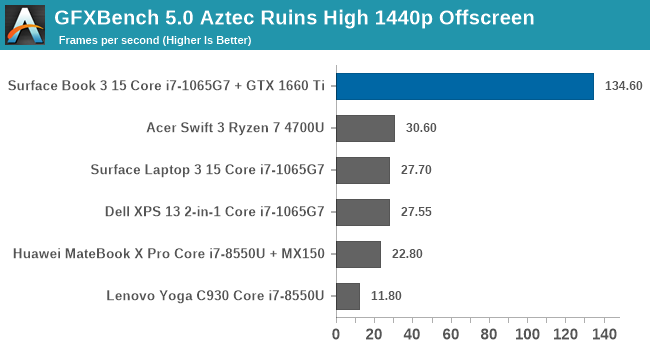
Kishonti’s GFXBench started offering DirectX 12 rendered tests with version 5.0 and instantly made it relevant again. The GTX 1660 Ti handles these tests with aplomb.
Tomb Raider

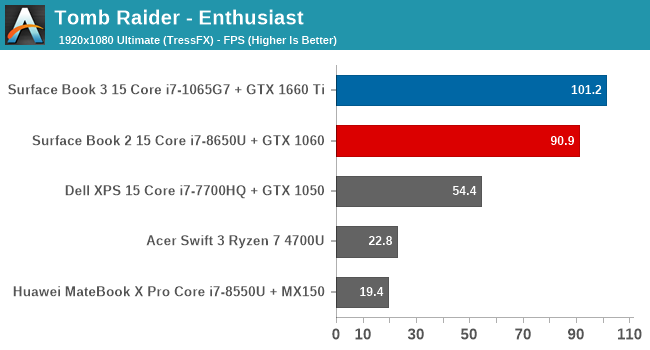
The original Tomb Raider game can be a challenge for devices with integrated GPUs, although the latest AMD Vega and Intel Iris Plus integrated GPUs have come a long way. On Value settings, the old Surface Book 2 was actually slightly ahead, but the Enthusiast level puts things back in the right order.
Rise of the Tomb Raider


The Tomb Raider sequel added DirectX 12 support and added a lot more visual fidelity, and as such the game is much more demanding. The new Surface Book 3 shows a big jump here.
Shadow of the Tomb Raider


The latest in the franchise is even more demanding. Interestingly the benchmark also shows how often the scene was GPU bound. On the Value settings, it was GPU bound only 8% of the time (and therefore 92% of the time it was CPU bound) but once the settings were turned up to 1920x1080 Highest plus TAA, the Surface Book 3 was GPU bound 93% of the test run.
Civilization VI
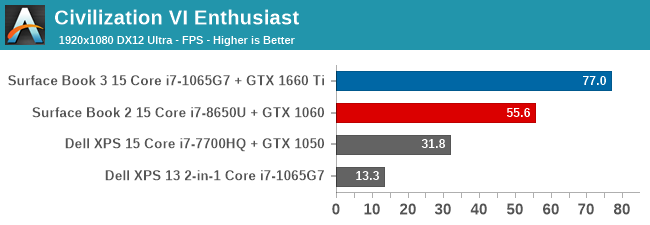
Once again, the Surface Book 3 shows a significant jump over the outgoing model.
Far Cry 5


Far Cry 5 is at the limits of what integrated GPUs can achieve right now, but the Surface Book 3 handles this game very well.
F1 2019


Codemasters’ F1 2019 is also playable on integrated graphics, but much more playable on the Surface Book 3.
GPU Conclusion
The NVIDIA GTX 1660 Ti, even in the Max-Q configuration as in this notebook, offers far more performance than the outgoing GTX 1060. The Surface Book 3 is not a “gaming laptop” by any means, but it certainly has the required chops to be used for gaming when needed. The integrated Xbox wireless for connecting a controller is also a perk, and a perk only found on the 15-inch version. The only downside is that the Surface Book’s 3:2 display can be a problem if the game is expecting 16:9, so your mileage may vary.
If you have a GPU-based productivity task though, the Surface Book 3 offers far more performance than other similar devices. The GTX 1660 Ti offers 50% more CUDA Cores than a GTX 1650 Ti. The Surface Book is somewhat compromised on CPU due to the CPU having to be behind the display, but the extra thermal capacity available by separating the heat loads sure lets them stuff a big GPU in the base.


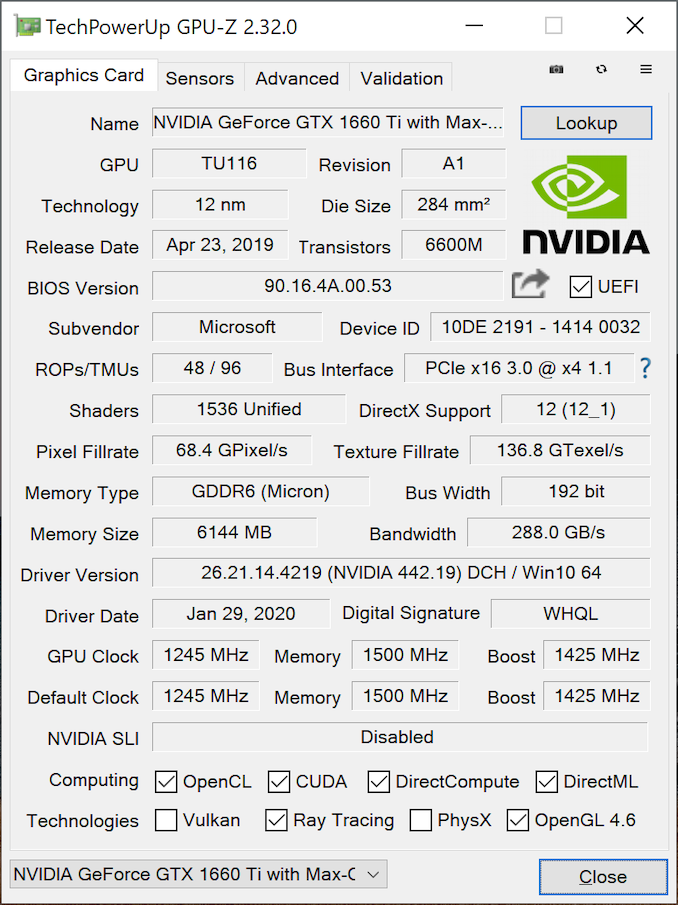








125 Comments
View All Comments
Xex360 - Wednesday, June 3, 2020 - link
It's very disappointing that they didn't use Ryzen APUs.But anyway it's very slow to do any real work on it, plus in their wisdom (or absence of thereof) didn't include a proper keyboard with keypad.
thesavvymage - Wednesday, June 3, 2020 - link
numpad laptops are a thing of the past. Anybody who NEEDS one probably works at a desk with a dock and can use a USB one. They take up a huge amount of keyboard space and rarely get used.drothgery - Wednesday, June 3, 2020 - link
This is going to be a comment on every premium laptop review until either Intel gets an 8-core U-series part out on 10 nm or smaller or Ryzen starts showing up in premium notebooks, isn't it?Anyway, no one's using Ryzen in premium laptops right now. Ryzen 4xxx is the first AMD notebook chip worthy of being in a premium laptop, erm, ever (even when AMD was stacking up quite nicely vs Intel on the desktop, low power parts were another story), and premium laptops have a longer lead time than simpler value and gaming designs. Come back again next fall, especially if Intel doesn't show plans for an 8-core/15 Watt Tiger Lake.
alufan - Thursday, June 4, 2020 - link
Funny that despite the AMD being a better product Dell etc still put intel into the best chassis with the best components wonder why that is...rebates perhapsDeicidium369 - Thursday, June 4, 2020 - link
Most likely in response to customers... I know it's hard to believe - but the world sees AMD as a bargain bin brand - right or wrong, that is the perception.Spunjji - Thursday, June 4, 2020 - link
"Brands have no power to change customer perceptions of value through the products they sell" is a bold claim.Retycint - Thursday, June 4, 2020 - link
It's not an instant transition, especially for the average consumer that doesn't follow tech news. Ryzen and AMD still has some catching up to do with regards to brand equity.Spunjji - Thursday, June 4, 2020 - link
On that front I agree completely - but if that were the only obstacle, you'd expect to see Dell beginning the transition. Asus have with the G14.It's a fairly simple equation - you draw on your existing brand credibility and add a new option. You advertise its strengths. Consumers who don't follow tech news don't know the difference between AMD and Intel, but they know what "same design, more cores, faster performance, less heat" means.
Deicidium369 - Friday, June 5, 2020 - link
Asus itself is not perceived as a premium brand - I have never owned an Asus laptop and avoid their motherboards and video cards like the plague - but have had several Asus monitors over the years - they had the first true GSync monitor way back when.ExarKun333 - Thursday, June 4, 2020 - link
This. AMD made huge inroads on this from 2000-2005 and really positioned themselves as the market leader. As a big user of this site and AT's BB then, we all jumped on much earlier but that was more from enthusiasts. Then Intel's Core arrived in 2006. And Intel swiftly started shifting back the performance brand, image and raw performance leads. 5 Years ago, AMD laptop marketshare was barely existent. As someone waiting to buy a gaming laptop right now, I really want a Ryzen-powered laptop with a Nvidia GPU, which isn't available above a 1660/2060. Ill bite when it is. :)